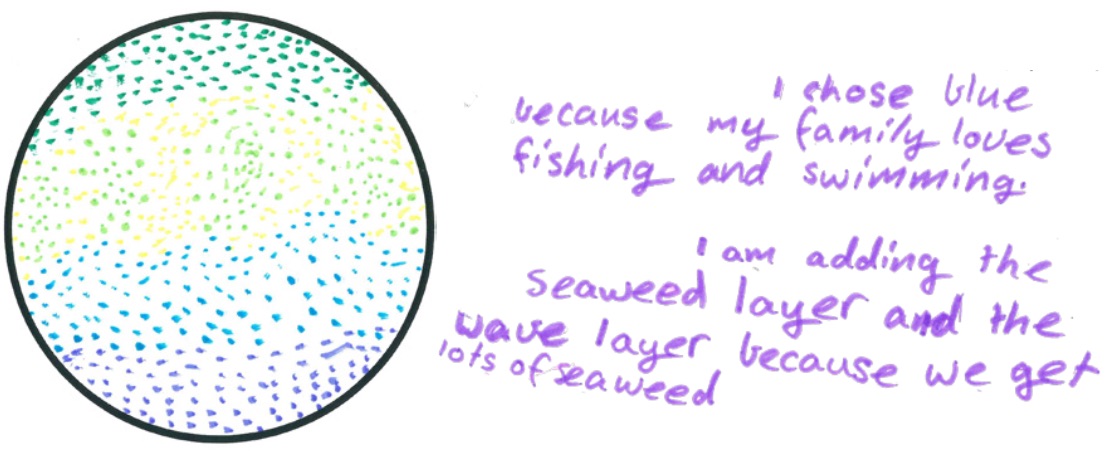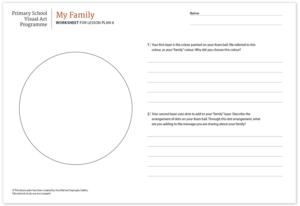

Activity 8
Dot Artwork Design
Students design a second layer of meaning onto their painted foam ball, using painted dots and colours to represent some more information they wish to share about their family.
Curriculum
Western Australian Curriculum Content Descriptions
Exploration of artworks from varying times and cultures that represent different styles, such as realistic, narrative and abstract.
Development of artistic processes and techniques to explore visual conventions through shape and colour to create artwork.
Australian Curriculum Version 8.3 Content Descriptions
Use materials, techniques and processes to explore visual conventions when making artworks (ACAVAM111).
Materials
Worksheet for Activity 8: Foam Ball Dot Design.
Design development equipment such as lead pencils, erasers, sharpeners.
Activity
Review previous lessons. Focus discussion on linking activities as part of a creative process. The purpose of the activities has been to scaffold skills and concepts towards the creation of a 3D artwork that shares student’s ideas about their own family.
Link discussion to Sarrita King’s artwork as the inspiration for this visual arts program. Recap some of the main features of Sarrita’s painting – theme of family, techniques used, use of layers both visually and to express/convey meaning in artwork.
Ask students: “Why do you think artists look at other artists’ artworks?”
Suggested example:
Imagine you are in a class where everyone has plain school bags. You cover your bag with drawings
of your family, home and pets - everything you love. Your friends are impressed by how the bag looks. They love it. They want you to show them how to do that. You explain which pens create each ect. One friend, Kim gets excited and uses the pens to decorate her bag with drawings of things that make her happy. She shows you - similar technique - but the art is different because it is all about Kim’s world. Your other friend Nat sits down every lunch hour and copies the pictures on your bag so that his bag
is exactly the same as yours. Rather than being influenced by your art Nat’s work is a copy or imitation. How would you feel about that? What is the difference between one friend’s art and the other’s?
Ask students to consider some ways artists can be influenced by others? What is the difference between “influence” and “copying”?
Suggested explanation
The artist Sarrita King wants people to celebrate the things she loves. Her culture, her country and her ancestors. She is happy to share stories about the techniques she uses to create certain effects in her art. Sarrita wants art students to learn about these techniques. Artists often learn art techniques from each other. Sarrita learnt from watching her Dad who was also an artist.
Sarrita is an Aboriginal artist and this artwork belongs to her because it is about what is important
to her. Aboriginal art belongs to Aboriginal people because it is about their culture and what is precious to them. As students of art, we have permission to learn about painting techniques that Aboriginal artists use. We don’t have permission to call our art Aboriginal art unless we are Aboriginal. We can be influenced and inspired to create our own art that is all about what matters to us.
In this art activity, we are using dots rather than lines to represent our ideas about our own family. By doing so, we can experience a painting technique Sarrita uses. This will help us understand the artistic decisions she makes and how colour plays an important role in creating the images we see in her artwork.
Explain worksheet:
First, ask students to consider their family background colour, then to start visualising what sort of designs (or even a theme) they could use in an arrangement of dots.
Discuss how, in this next layer of work, the intention is not to reproduce a photograph-like image but a design which represents or reminds them of something. For example, the ocean could be represented by a wavy line repeated continually across the foam ball, or camping in the bush could be dots painted in bush-green in the shape of leaves floating around the foam ball, etc. Symbols could also be used.
Using coloured textas, plan a possible design. For this shared example, the teacher also discussed with students how the colours of textas were limited compared to the paint colours they could mix, so that their worksheet design is only a suggestion or a direction for their dot painting. The final one using paints may look different.
Question 1: Review the idea of using layers. The first layer is the colour the student chose to paint their foam ball. Question 1 asks students to explain why they chose this colour.
Question 2: The second layer will be the dots students will paint on top of the first layer. Through this dot arrangement students have the opportunity to add to the message they are sharing about their family. Question 2 asks them to describe this arrangement.
Time
For this documented project, Year 4 students required one 50-minute lesson.
© This lesson plan has been created by Ana Nail and Japingka Gallery. Educational study use encouraged.
Overview | Lesson 1 | Lesson 2 | Lesson 3 | Lesson 4 | Lesson 5 | Lesson 6 | Lesson 7 | Lesson 8 | Lesson 9 | Lesson 10 | Lesson 11 | Lesson 12 | Lesson 13

